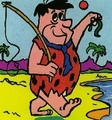

 |
Methods of Fishing for Steelhead |
 |
Fishing Methods Have Evolved : Initially (50-60 years ago) in the Pacific Northwest about all the steelhead fishing was done from the bank of a river or stream, by casting and drifting through a run. It would have been very unusual to see someone that had a boat that would float down a river dragging plugs.
The basic gear then was a fiberglass rod from 8 to 9' long and a level-wind reel. Some of us thought those old Pflueger Supreme reels were the cat's meow. However I challenge you to compare them with today's casting reels, these old ones are not even in the same planet. Then along came the Ambassadeurs, which seemed to dominate the river bank, and some can still be seen. You would not see a lot of the open faced spinning reels early on as the quality was not that good. Bearings were basically non existent, just a shaft through a aluminum cover, or possibly a bronze bushing. And pot metal or plastic gears did not last long for the serious steelheader.
The old Mitchell 300 spinning reels functioned, but were not that smooth
running, had a jerky drag and many times after continued use on large steelhead, would fry
the internal pot metal gears. I still have one of them and a functioning Airex-Bache
Brown #5 spinning reel that I bought new in May of 1955 along with the Betts 8'
6" solid glass steelhead spinning rod. This was a durable rod but far from
being sensitive, so I made a second more sensitive tip section from hollow glass
that has seen a lot of use.
Line and leader was always monofilament, using pencil lead as a weight.
This lead could be attached to a dropper by using a surgical tubing coupler or
by flattening one end and punching a small hole in the lead, then snapping the
lead onto a cheap snap swivel.
The lure was usually salmon/steelhead eggs cured in borax. Now there are a lot of commercial bait cures available. In use, you cast out into a seam, let the lead bounce bounce along the bottom, with a short leader to the bait which of course followed the lead.
Hooks were usually a size #2 or the slightly larger #1. Many modern fishers will use red hooks instead of the older standard nickel plated ones.
You maintained control, holding it up off the bottom just enough to hope you did not get tangled in rocks or an underwater limb. The secret was to be able to distinguish between the weight tapping the bottom between the hesitation/pickup by a fish. You usually set the hook on nothing or a rock many more times than it was a fish. If you missed this "bite", you may not have known it was there until you reeled back in and the eggs were partly stripped off. It took a lot of experience to be able to distinguish between rock or stick bite and fish bites.
Then someone concluded that maybe if you added some colored yarn to the egg bait, that the fish would get their teeth tangled in the yarn, giving the fisherperson a bit longer time to set the hook, once they felt the bite. About that time, another idea was born, add a small floating object on the line next to the eggs. This allowed the eggs to float up about a foot off the bottom and nearer to where a suspected steelhead may be laying. This brought into being the Okie Drifter. Then some fishermen found that just the Drifter and yarn would catch fish. Then Corkies and other imitations of the Okie were invented, and of course performed the same as the Okie. So then you had a variety and of course different colors to choose from.
As for artificials, a friend of mine who was a steelhead fisherman came up with a lure that he called a "pocket shrimp". It was made rather simply by using a 1' foam sheet, spray painting each side with a bright florescent orange paint, then using a spent 270 Winchester cartridge case (the gun he shot) with the head cut off, he cookie cut out many of these about 1/4" round foam slugs that had a bright orange eye on each end. He simply slid the foam under the egg loop on his egg loop hook with 1/2 of it protruding on each side and we caught fish on it with or without eggs. The foam helped float the hook up off the bottom.
Times Changed : As time went on, sand shrimp became the bait of choice. And rightfully so as this was one of the natural types of food that these fish were accustomed to eating when they spent their time in salt water. The good part about this bait is that you could dig your own about any time of the year if you were in a location where they were, or purchase live ones in pint foam containers at bait stores. This helped considerably as good bought roe/eggs could be hard to come by and expensive many times during the year. However these shrimp do not live long and once they die, it seems that Steelhead are not that receptive of slurping them down.
For a while spinners and spoons were the rage and yes, they do catch fish. With the spinners being easier to fish, but if you put in your time and pay your dues with a spoon it can work quite well. It still has it's place in certain water.
Did I forget to mention plugs? These could be Flatfish or Wriggle Warts, both of which have proven themselves, either casting or backtrolling.
Now you will now even see usage of pink rubber worms. These use a wire threader to run the leader thru the worm, leaving the hook at the rear of the worm.
| Here you see a threaded worm with a winged cheater in front | Here is a pink worm that was inhaled by a Steelhead |
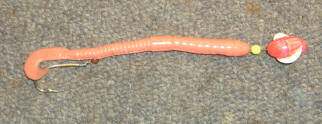 |
 |
All the while rods
have underwent great improvements. The solid glass rods became
obsolete years ago, being replaced by hollow fiberglass which were considerably more
sensitive. Then as time passed, Graphite was introduced into rod
manufacture and we got lighter, longer and MORE SENSATIVE rods. Then
a composite of the Graphite and fiberglass came along for for light, SENSATIVE and REALLY
STRONG rod.
Reels improved, some still use the level-wind "baitcasters", where the Ambassadeurs are still hard to beat, but probably more have shifted to the newer multi stainless steel ball bearing Shimano Calcuttas for the bait casters. Or for the more modern open faced spin casting reels for that clan. And importantly, drags have improved greatly on all reels also.
As for line, many still use monofilament, while most die-hards have shifted to the non stretch braid type. Each has it's benefits and places, so unless you try the braid, don't condemn it simply because you are old school.
Sinkers have also went through a change, while many still use pencil lead, slinkies slid into being. These are nothing more that brown parachute cord filled with lead buckshot balls and seared on the ends encapsulating the lead. The cord is porous enough to allow you to snap a snap swivel into one end just like you did with pencil lead. Different weights could be made using 3, 4, 5, or more lead balls. These seem to slither along a rocky bottom better than the solid pencil lead, equating to less snag-ups. Plus the fish's bite was easier to detect.
Then from north of the boarder we were enlightened with floats, sometimes called a bobber. Sure you probably used floats for fishing for trout or perch years ago. But these were vastly improved. You now will see many different styles, some made of hard foam and like large eggs, others simply a 1/2" or 3/4" foam rod with a hole diagonally through it to allow the line to pass through. In use your line wrapped partly around this foam rod, holding it in place on the mainline. These foam rods look amazingly like "Backing Rods" sold a a building supply business for taking up excess gap before the hole is caulked. Some use a bead above and below with a special float slider knot that can be adjusted rather quickly to change your depth of to the lure. Some fishermen hate to admit they are using a float, so you may hear the term "Strike Indicator" being used, same old float, just different more dignified name applied to it.
Now with the float, a bankie can cover water a lot more that just beating it with a spinner, spoon or eggs. With the float, you can still use bait, or in the last few years a small lead-head jig has proven very effective, especially under Strike Indicator. This also helped the novice greatly as being able to "Read" the river was not as important now as it was years ago.
Boat Fishing :
Now for a boater, being able to drift peacefully down a river casting
into likely seams works quite well. This is usually done with a drift boat
and the rower, just slightly not maintaining a drift position, but slowly backing down
the river. The rods are out and the person in the center can be "backdrifting",
this has also been called "boondogging". Others in the boat could of
course cast out to the side and reel back in. However the hardest
part of this was that if you drifted very far down river, you had to make
arrangements to have your vehicle and trailer driven down to your take-out.
One fisherman I know carries a small motor scooter in his drift boat so he can
use it to go back upriver to get his vehicle.
Then the jet sled boat enters the scene. This allows the fishermen
to cover a lot more water, drift, usually using a electric trolling motor to maintain position, then at
the end of the drift, power up and run back upstream to make another pass or
back to the launch.
Here the boat can be drifting either parallel or 90 degrees to the shore,
casting and retrieving as needed to cover all the water. This has
become known as "side-drifting". Now combine this with the float system
and you have the best of both worlds in "bobber drifting".
For the jet-sled fisher, they have more options of where/how to fish than the drift boater. Here the operator can hover or has the ability to hold a position, letting the fisherperson cast into an exact hole. And with that the guides greatly expanded their domain, while taking 3 to 6 clients out.
In the photo below, you can see the lure on the rods, a pink corky and salmon eggs. This fish would have been taken side-drifting.
| The lady's first day on the water steelheading, NICE FISH & expert guide |
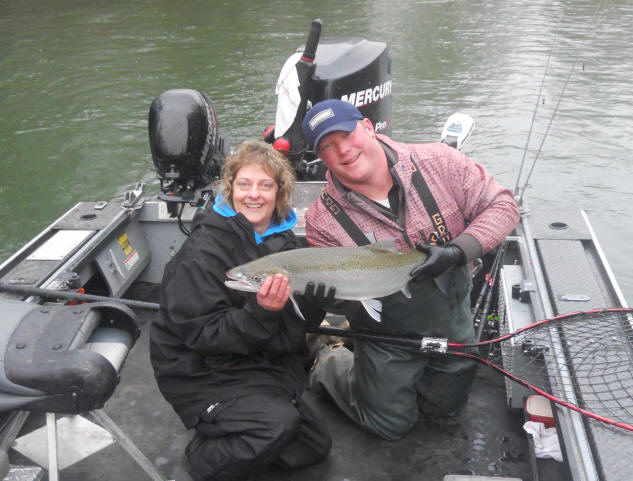 |
Bait Cures : And now we have a lot of premade roe cures as compared to just the borax. Most of these have a choice of bright colors if that is what you want, and bite enhancement additives included. Some of these colors are so penetrating that many bait fishermen now prefer wear surgical gloves to protect the finger coloration as seen in the header photo above.
And all the while our tackle boxes needed to be updated with all the
new stuff designed to catch fisherpersons.
| Now that is a nice Steelhead |
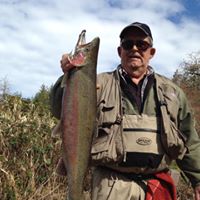 |
Bankies : The drifting method still stays pretty much the same with corkies or eggs, but with upgraded equipment. Rods can run from between 8' to 10', with the longer rods usually used on bigger water. It is about impossible to use a long rod on a small stream, without the mult-chance of breaking it. For those casting spinners, this seems to work best using a casting rod/levelwind reel, as usually here accuracy is important.
Lines will generally now be braid with a short top shot of mono, which gives the fisherperson more sensitivity as to what the lure is doing along with the better abrasive resistance of the Flouro-Carbon or mono.
Steelhead
will be in the brushy holes or under/behind downed logs/limbs. As for
hooks, for the most part, you might consider finding a fine wired hook, that can
be straightened out WHEN it becomes snagged, whereby saving your tackle.
Many times you can re-straighten it.
For those of you who think you
need the double strong wired hook that won't be straightened out on a big fish,
just how many big fish are left??
In the photo below, the corkie between the two hooks adds buoyancy enough to
raise the lure up out of the rocks and more in line with the path of the fish
near the bottom. These fish tend to not go out of their way for
their food, or chase it. Therefore more explaining that they are fish of
1,000 casts.
| Here a gob of cured eggs held on by an egg loop knot tied on the front hook |
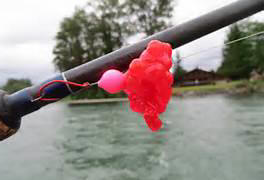 |
Another lure has surfaced in recent years, that being a jig. These can be very effective when you are fishing water that has been previously hammered, as it is something different. But again a learning curve on these.
Other gear needed. You are
going to have to have some means of carrying your gear. Some still prefer
the fishing vest with lots of pockets, while others simply use a small
back-pack. These back-packs tend to free you up from restraints of the
bulky cumbersome at times vest.
One note that you can observe when you see a photo of a fish being held just out of the water. If the fish's eyes are looking straight out, it is dead, but if the eyes are looking down, it is still alive.
Low Flows : Some waters have Steelhead runs throughout the year or in late winter when the flows are low, requiring more stealth. Here you may have to lower your leader strength, and downsize the lure size. I know few guides who have profected their approach/lures and guard this information very closely.
Has The End Came?? : The 2021 has been totally changed for the Washington coastal Steelhead fishing. With most of these river CLOSED to any winter fishing, because of low returns. WHY? You will see many fingers being pointed, but what ever the issue is my guess is OVERHARVEST. And we recreational can not even catch and release. Here the tribes can legally take these GAMEFISH. !!!
Copyright © 2014 - 2021 LeeRoy Wisner All Rights Reserved
Back to the Main
Ramblings Page
Originated 01-06-14, Last updated 12-08-2021 *
Contact the author